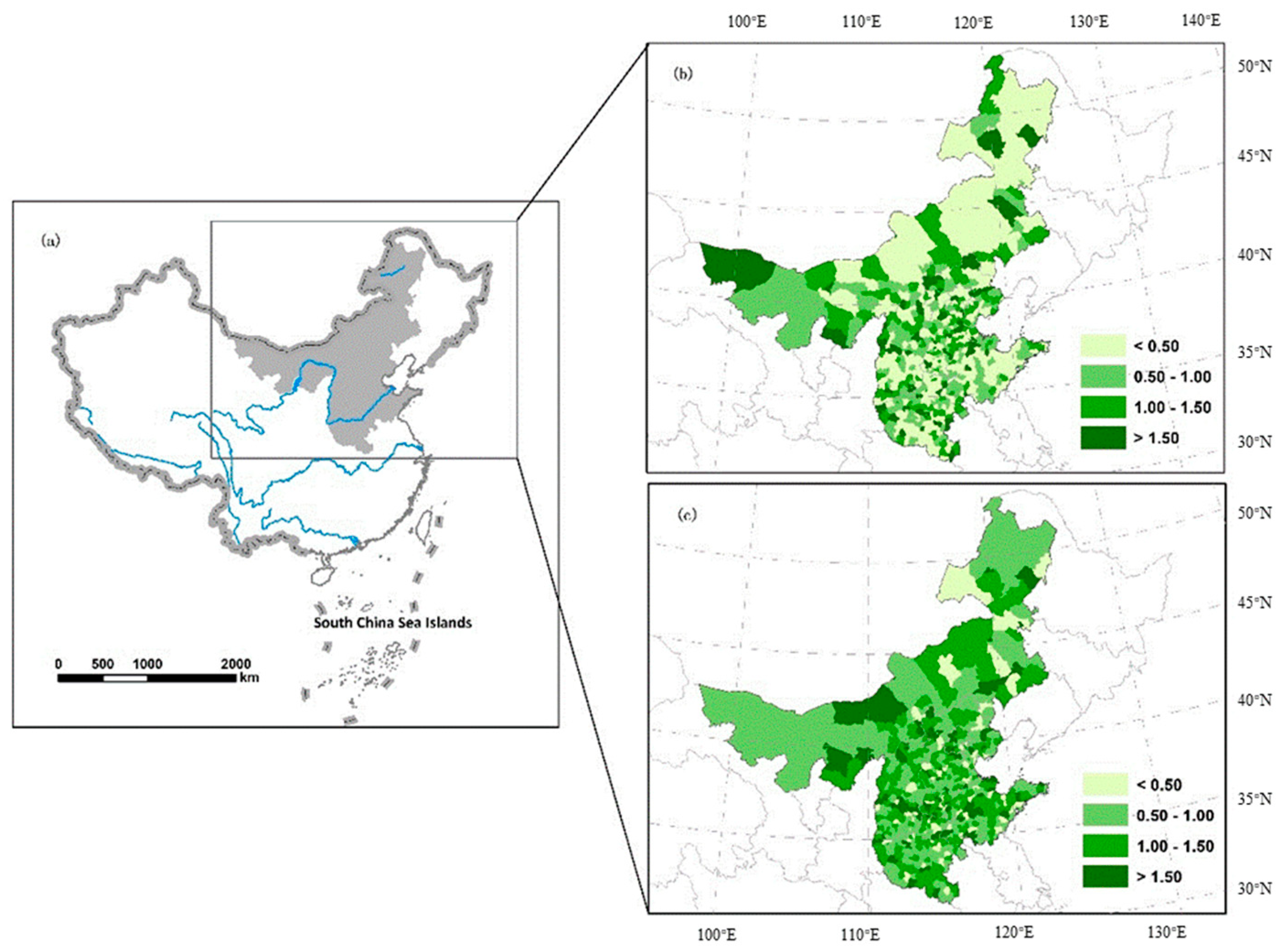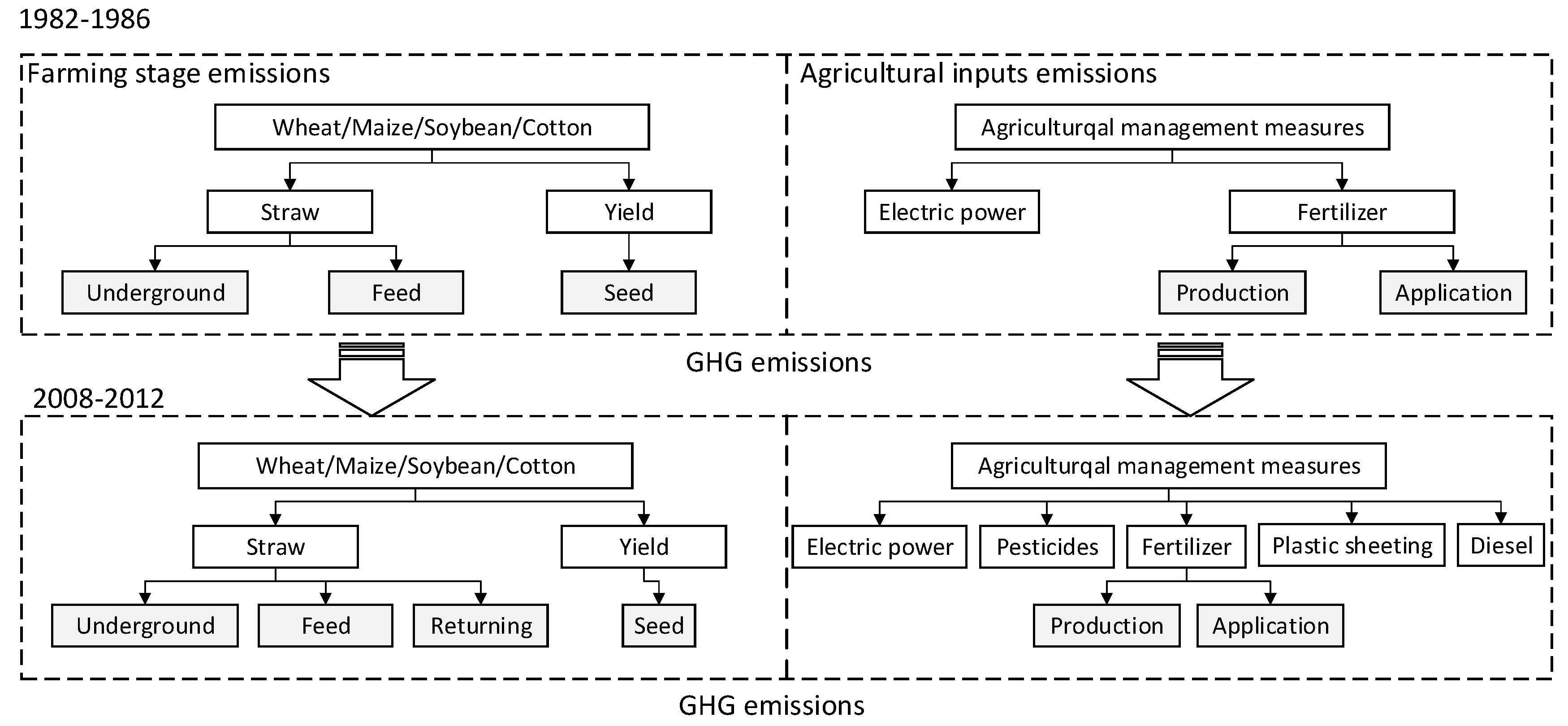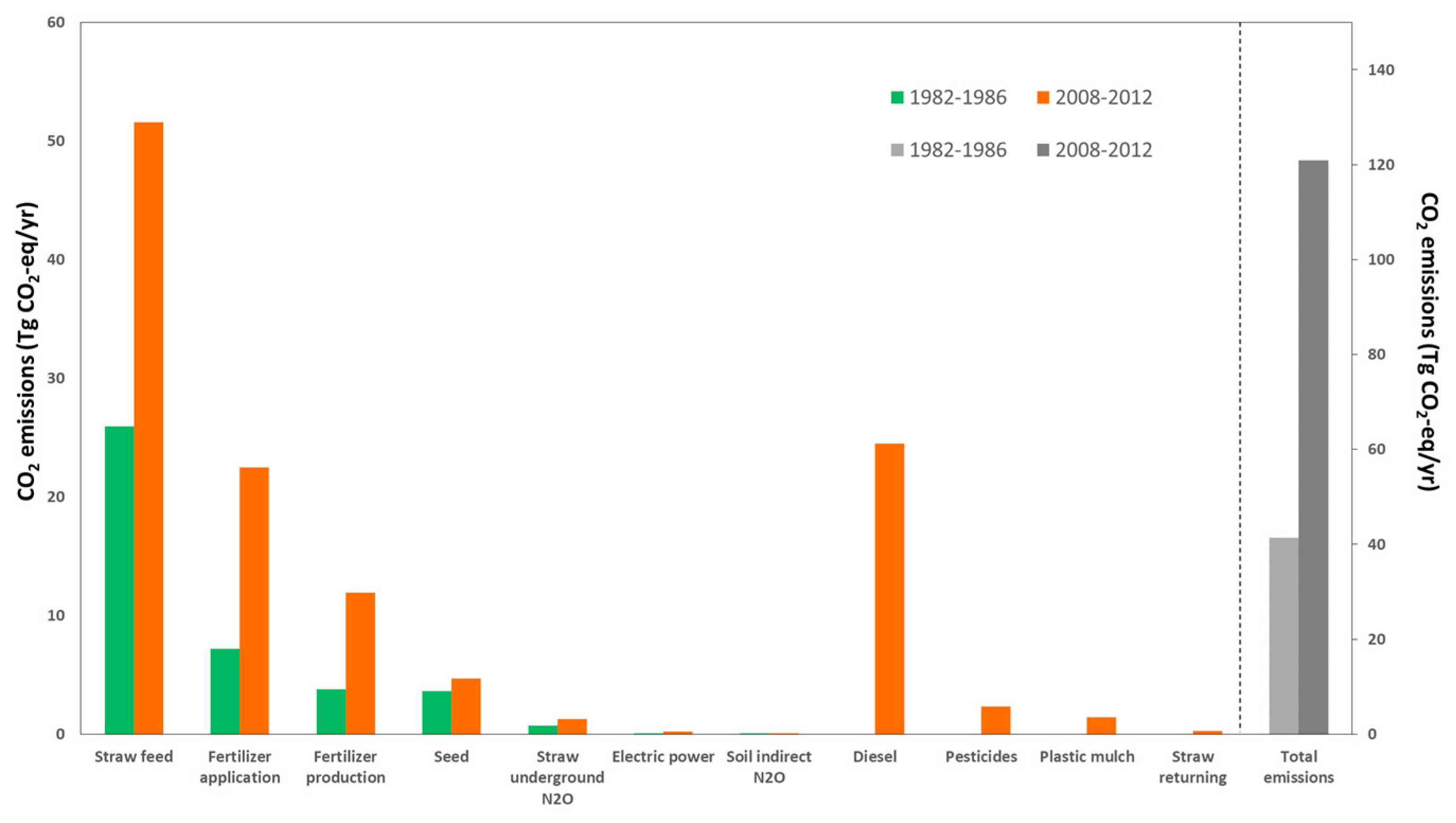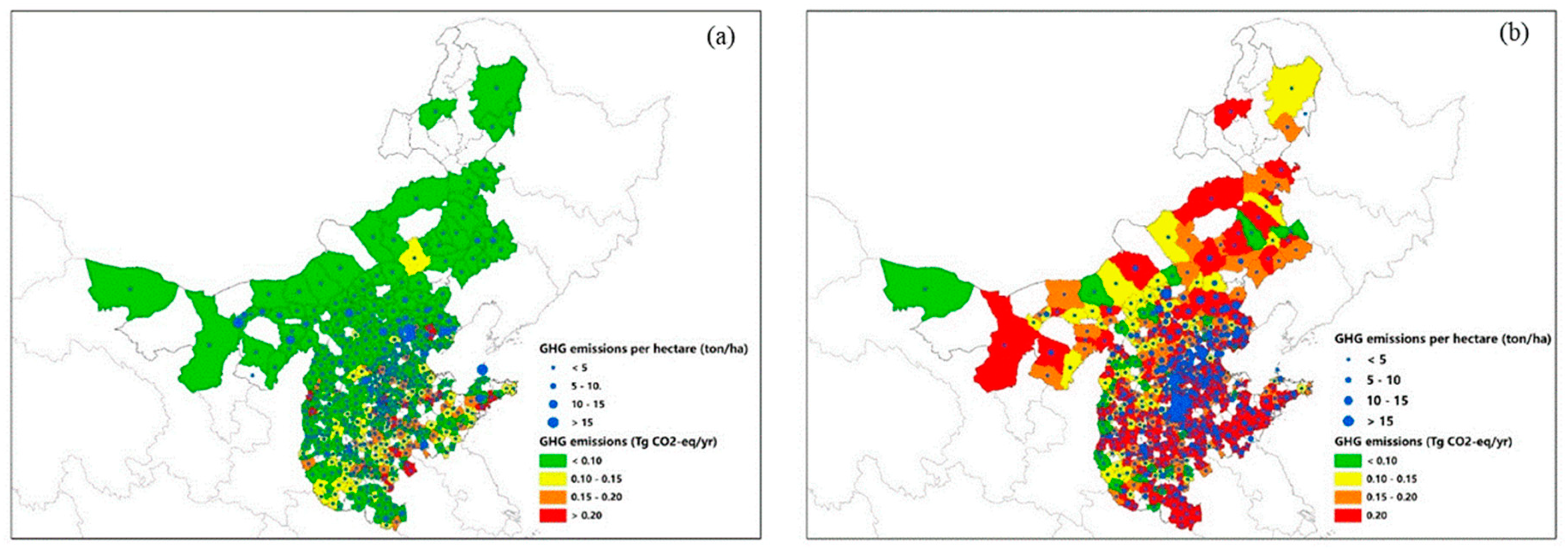Multiple Cropping System Expansion: Increasing Agricultural Greenhouse Gas Emissions in the North China Plain and Neighboring Regions
Abstract
1. Introduction
2. Data and Methodology
2.1. Study Region and Data
2.2. LCA System Boundary of MCS GHG Emissions
2.3. Calculation of GHG Emissions
2.3.1. CO2 Emissions from Seeds
2.3.2. N2O Emissions from Soil
2.3.3. CH4 Emissions from Straw Feed
2.3.4. CO2 Emissions from Agricultural Inputs
2.4. Contribution of MCS to the GHG Emission Ratio
3. Results
3.1. Agricultural GHG Emissions in the NCP and Neighboring Regions
3.2. Spatial and Temporal Evolution of GHG Emissions
3.3. Analysis of the Driving Factors of Agricultural GHG Emissions
3.4. Contribution of MCSs to GHG Emissions
4. Discussion
5. Conclusion
Funding
Conflicts of Interest
References
- Li, F.F.; Xu, Z.; Ma, H. Can China achieve its CO2 emissions peak by 2030? Ecol. Indic. 2018, 84, 337–344. [Google Scholar] [CrossRef]
- Wang, H.M.; Dai, H.C.; Dong, L.; Xie, Y.; Geng, Y.; Yue, Q.; Ma, F.M.; Wang, J.; Du, T. Co-benefit of carbon mitigation on resource use in China. J. Clean. Prod. 2018, 174, 1096–1113. [Google Scholar] [CrossRef]
- National Development and Reform Commission (NDRC). The People’s Republic of China Initial National Communication on Climate Change. 2004. Available online: http://unfccc.int/essential_background/library/items/3599.php?such=j&symbol=CHN/COM/1%20B#beg (accessed on 2 April 2019).
- National Development and Reform Commission (NDRC). Second National Communication on Climate Change of the People’s Republic of China. 2012. Available online: http://unfccc.int/essential_background /library/items/3599.php?rec=j&priref=7666#beg (accessed on 5 April 2019).
- Tian, Y.; Zhang, J.B.; He, Y.Y. Research on Spatial-Temporal Characteristics and driving factor of agricultural carbon emissions in China. J. Integr. Agric. 2014, 13, 1393–1403. [Google Scholar] [CrossRef]
- Ma, D.; Chen, W.Y. China’s carbon emission peak path—Based on China TIMES model. J. Tsinghua Univ. (Sci. Technol.) 2017, 57, 1070–1075. [Google Scholar]
- Lin, B.Q.; Fei, R.L. Regional differences of CO2 emissions performance in China’s agricultural sector: A malmquist index approach. Eur. J. Agron. 2015, 70, 33–40. [Google Scholar] [CrossRef]
- Li, B.; Zhang, J.B.; Li, H.P. Research on spatial-temporal characteristics and affecting factors decomposition of agricultural carbon emission in China. China Popul. Resour. Environ. 2011, 21, 80–86. [Google Scholar]
- Li, Z.J.; Sui, P.; Wang, X.L.; Yang, X.L.; Long, L.; Cui, J.X.; Yan, L.L.; Chen, Y.Q. Comparison of net GHG emissions between separated system and crop-swine integrated system in the North China Plain. J. Clean. Prod. 2017, 149, 653–664. [Google Scholar] [CrossRef]
- Ju, H.; Marijn, V.; Lin, E.D.; Xiong, W.; Li, Y.C. The impacts of climate change on agricultural production systems in China. Clim. Chang. 2013, 120, 313–324. [Google Scholar] [CrossRef]
- Yang, X.G.; Liu, Z.J.; Chen, F. The possible effect of climate warming on northern limits of cropping system and crop yield in China. Agric. Sci. China 2011, 10, 585–594. [Google Scholar] [CrossRef]
- Yang, X.G.; Chen, F.; Lin, X.M.; Liu, Z.J.; Zhang, H.L.; Zhao, J.; Li, K.N.; Ye, Q.; Li, Y.; Lv, S.; et al. Potential benefits of climate change for crop productivity in China. Agric. For. Meteorol. 2015, 208, 76–84. [Google Scholar] [CrossRef]
- Cook, R.J. Toward cropping system that enhance productivity and sustainability. Proc. Natl. Acad. Sci. USA 2006, 103, 18389–18394. [Google Scholar] [CrossRef] [PubMed]
- Liu, Y.; Wang, E.L.; Yang, X.G.; Wang, J. Contributions of climatic and crop varietal changes to crop production in the North China Plain, since the 1980s. Glob. Chang. Biol. 2010, 16, 2287–2299. [Google Scholar] [CrossRef]
- Jeong, S.J.; Ho, C.H.; Piao, S.L.; Kim, J.W.; Ciais, P.; Lee, Y.B.; Jhun, J.G.; Park, S.K. Effects of double cropping on summer climate of the North China Plain and neighbouring regions. Nat. Clim. Chang. 2014, 4, 615–619. [Google Scholar] [CrossRef]
- Piao, S.L.; Ciais, P.; Huang, Y.; Shen, Z.H.; Peng, S.S.; Li, J.S.; Zhou, L.P.; Liu, H.Y.; Ma, Y.C.; Ding, Y.H.; et al. The impacts of climate change on water resources and agriculture in China. Nature 2010, 467, 43–51. [Google Scholar] [CrossRef] [PubMed]
- Guo, J.P. Advances in impacts of climate change on agricultural production in China. J. Appl. Meteorol. Sci. 2015, 26, 1–11. [Google Scholar]
- Des, P.L. Good Practice Guidance and Uncertainty Management in National Greenhouse Gas Inventories; Intergovernmental Panel on Climate Change (IPCC): Geneva, Switzerland, 2014; pp. 1–94. [Google Scholar]
- Biswas, W.K.; Barton, L.; Carter, D. Global warming potential of wheat production in Western Australia: A life cycle assessment. Water Environ. J. 2008, 22, 206–216. [Google Scholar] [CrossRef]
- Athena, B.; Regina, B. The world’s first neutral coffee: Lessons on certification and innovation from a pioneer case in Costa Rica. J. Clean. Prod. 2018, 189, 485–501. [Google Scholar]
- Li, Y.; Ge, Y.X.; Liang, Y. Relationship between agricultural carbon emissions and agricultural gross value of output. Chin. J. Agric. Resour. Reg. Plan. 2013, 34, 60–65. [Google Scholar]
- Goglio, P.; Smith, W.N.; Grant, B.B.; Desjardins, R.L.; Gao, X.; Hanis, K.; Tenuta, M.; Campbell, C.A.; McConkey, B.G.; Nemecek, T.; et al. A comparison of methods to quantify greenhouse gas emissions of cropping systems in LCA. J. Clean. Prod. 2018, 172, 4010–4017. [Google Scholar] [CrossRef]
- Godfray, H.C.J.; Beddington, J.R.; Crute, I.R.; Haddad, L.; Lawrence, D.; Muir, J.F.; Pretty, J.; Robinson, S.; Thomas, S.M.; Toulmin, C. Food security: The challenge of feeding 9 billion people. Science 2010, 327, 812–818. [Google Scholar] [CrossRef]
- Dong, J.W.; Xiao, X.M.; Kou, W.L.; Qin, Y.W.; Zhang, G.L.; Li, L.; Jin, C.; Zhou, Y.T.; Wang, J.; Biradar, C.; et al. Tracking the danamics of paddy rice planting area in 1986–2010 through time series Landsat images and phenology-based algorithms. Remote Sens. Environ. 2015, 160, 99–113. [Google Scholar] [CrossRef]
- Li, X.; Mu, Y.Y.; Fu, W.G. Empirical analysis of factors affecting wheat production in China in recent ten years. Rural Econ. 2009, 10, 32–34. [Google Scholar]
- Li, C.H. Analysis on Market of Maize Seed in China; China Agricultural University: Beijing, China, 2004; pp. 53–54. [Google Scholar]
- Li, L.J. Involving Regularities in Recent 50 Years and Future Trends in 2020 on Farming System in China; China Agricultural University: Beijing, China, 2004; pp. 204–206. [Google Scholar]
- Shang, Y.Y. The Study on the Cost and Economic Benefits of BT Cotton in Our Country; Huazhong Agricultural University: Wuhan, China, 2011; pp. 1–52. [Google Scholar]
- Liu, J.S. Analyses on the Distribution Pattern of the Crop-Straw Resource and the Status Quo of Its Application in China; China Agricultural University: Beijing, China, 2005; pp. 1–34. [Google Scholar]
- Wang, R.F.; Zhang, J.W.; Dong, S.T.; Liu, P. Present situation of maize straw resource utilization and its effect in main regions of China. Chin. J. Appl. Ecol. 2011, 22, 1504–1510. [Google Scholar]
- National Development and Reform Commission (NDRC). The Provincial Greenhouse Gas Inventories. Available online: http://www.chinadmd.com/file/puexsrrwv3 owoooir3arvepc_1.html (accessed on 18 April 2019).
- Guo, D.S.; Huang, C.H. Spatial and temporal distribution of crop straw resources in past 10 years in China and its use pattern. Southwest China J. Agric. Sci. 2016, 29, 948–954. [Google Scholar]
- Zhao, R.; Zhao, X.; Pu, C.; Liu, S.; Xue, J.; Zhang, X.; Chen, F.; Zhang, H. Meta-analysis on effects of residue retention on soil N2O emissions and influence factors in China. Trans. Chin. Soc. Agric. Eng. 2015, 31, 1–6. [Google Scholar]
- Intergovernmental Panel on Climate Change (IPCC). IPCC Guidelines for National Greenhouse Gas Inventories; IGES: Hayama, Japan, 2006. [Google Scholar]
- Wang, Y.J.; Wang, H.Y.; Gao, C.Y.; Wang, L.; Bi, Y.Y. Quantitative estimation method and its application to rice, wheat and corn straw residues left in field. Trans. Chin. Soc. Agric. Eng. 2015, 31, 244–250. (In Chinese) [Google Scholar]
- Ha, N.; Feike, T.; Back, H.; Xiao, H.F.; Bahrs, E. The effect of simple nitrogen fertilizer recommendation strategies on product carbon footprint and gross margin of wheat and maize production in the North China Plain. J. Environ. Manag. 2015, 163, 146–154. [Google Scholar] [CrossRef]
- Snyder, C.S.; Bruulsema, T.W.; Jensen, T.L.; Fixen, P.E. Review of greenhouse gas emissions from crop production systems and fertilizer management effects. Agric. Ecosyst. Environ. 2009, 133, 247–266. [Google Scholar] [CrossRef]
- West, T.O.; Marland, G. A Synthesis of carbon sequestration, carbon emissions, and net carbon flux in agriculture: Comparing tillage practices in the United States. Agric. Ecosyst. Environ. 2002, 91, 217–232. [Google Scholar] [CrossRef]
- Riano, B.; Garcia-Gonzalez, M.C. Greenhouse gas emissions of an on-farm swine manure treatment plant-comparison with conventional storage in anaerobic tanks. J. Clean. Prod. 2015, 103, 542–548. [Google Scholar] [CrossRef]
- Dace, E.; Muizniece, I.; Blumberga, A.; Kaczala, F. Searching for solutions to mitigate greenhouse gas emisisons by agricultural policy decisions—Application of system dynamics modeling for the case of Latvia. Sci. Total Environ. 2015, 527, 80–90. [Google Scholar] [CrossRef] [PubMed]






| Parameter | 1982–1986 | 2008–2012 | Reference | ||||||
|---|---|---|---|---|---|---|---|---|---|
| Wheat | Maize | Soybean | Cotton | Wheat | Maize | Soybean | Cotton | ||
| Seeds per ha (kg/ha) | 268.800a | 52.5000b | 45.000c | 18.000d | 268.800a | 52.500b | 45.000c | 18.000d | a: Li et al., 2009 [25]; b: Li, 2004 [26]; c: Li, 2004 [27]; d: Shang, 2011 [28] |
| EFseed (kgCO2-eq/kg) | 1.160 | 1.220 | 1.160 | 1.160 | 1.160 | 1.220 | 1.160 | 1.160 | Liu et al. 2010 [14] |
| Straw feed ratio | 0.126 | 0.340 | 0.207 | 0.002 | 0.126 | 0.199e | 0.207 | 0.002 | Liu, 2005 [29]; e: Wang, 2011 [30] |
| CH4 conversion factor | 0.070 | 0.070 | 0.070 | 0.070 | 0.070 | 0.070 | 0.070 | 0.070 | NDRC, 2011 [31] |
| Straw returning ratio | 0.000 | 0.000 | 0.000 | 0.000 | 0.237 | 0.436e | 0.189 | 0.026 | Liu, 2005 [29]; e: Wang, 2011 [30] |
| Straw ratio | 1.170 | 1.040 | 1.600 | 3.000 | 1.170 | 1.040 | 1.600 | 3.000 | Guo and Huang, 2016 [32] |
| Dry weight ratio | 0.870 | 0.860 | 0.860 | 0.830 | 0.870 | 0.860 | 0.860 | 0.830 | NDRC, 2011 [31] |
| Root crown ratio | 0.166 | 0.170 | 0.130 | 0.200 | 0.166 | 0.170 | 0.130 | 0.200 | NDRC, 2011 [31] |
| Carbon contentstraw | 0.485 | 0.471 | 0.485 | 0.485 | 0.485 | 0.471 | 0.485 | 0.485 | IPCC, 2014 [18] |
| Nitrogen contentstraw | 0.005 | 0.006 | 0.018 | 0.005 | 0.005 | 0.006 | 0.018 | 0.005 | NDRC, 2011 [31] |
| Sown area (106 ha) | 9.990 | 5.475 | 2.002 | 2.709 | 12.335 | 11.200 | 1.707 | 2.333 | China Rural Statistical Yearbook, 1982–2009 |
| Yield (Tg) | 31.709 | 20.393 | 2.154 | 2.283 | 68.577 | 67.075 | 3.273 | 2.608 | China Rural Statistical Yearbook, 1982–2009 |
| Parameter | Activity (1982–1986) | Activity (2008–2012) | Unit | EF | Unit | Reference | ||||||
|---|---|---|---|---|---|---|---|---|---|---|---|---|
| Wheat | Maize | Soybean | Cotton | Wheat | Maize | Soybean | Cotton | |||||
| Fertilizer application | 2.10 | 1.15 | 0.42 | 0.57 | 5.95 | 5.41 | 0.82 | 1.13 | Tg | 0.0056a/0.0057 | kgN2O-N/kg | NDRC, 2011 [31] |
| Fertilizer production | 2.10 | 1.15 | 0.42 | 0.57 | 5.95 | 5.41 | 0.82 | 1.13 | Tg | 0.8956 | kgCO2-eq/kg | West et al., 2002 [38] |
| Electric power | 31.60 | 17.32 | 6.33 | 8.57 | 0.01 | 0.01 | 0.00 | 0.00 | 109 KW | 1.03025/0.89355 b | Kg/KW.h | NDRC, 2004 [3], 2012 [4] |
| Pesticides | 0.16 | 0.14 | 0.02 | 0.03 | Tg | 6.5800 | kgCO2-eq/kg | Li et al. 2013 [21] | ||||
| Plastic mulch | 0.12 | 0.11 | 0.02 | 0.02 | Tg | 5.1800 | kgCO2-eq/kg | Li et al., 2011 [8] | ||||
| Diesel | 3.30 | 3.00 | 0.46 | 0.62 | Tg | 3.3200 | kgCO2-eq/kg | Li et al., 2013 [21] | ||||
| Emissions | 1982–1986 | 2008–2012 | Total Emissions 1982–1986 | Total Emissions 2008–2012 | ||||||
|---|---|---|---|---|---|---|---|---|---|---|
| Wheat | Maize | Soybean | Cotton | Wheat | Maize | Soybean | Cotton | |||
| Straw underground N2O | 0.09 | 0.06 | 0.55 | 0.01 | 0.20 | 0.21 | 0.83 | 0.02 | 0.71 | 1.26 |
| Straw feed | 9.68 | 14.76 | 1.46 | 0.03 | 20.93 | 28.41 | 2.22 | 0.03 | 25.93 | 51.59 |
| Straw returning | - | - | - | - | 0.00 | 0.26 | 0.03 | 0.00 | - | 0.29 |
| Fertilizer application | 3.56 | 1.95 | 0.71 | 0.97 | 10.07 | 9.14 | 1.39 | 1.90 | 7.19 | 22.50 |
| Fertilizer production | 1.88 | 1.03 | 0.38 | 0.51 | 5.33 | 4.84 | 0.74 | 1.01 | 3.80 | 11.92 |
| Electric power | 0.03 | 0.02 | 0.01 | 0.01 | 0.11 | 0.10 | 0.01 | 0.02 | 0.07 | 0.24 |
| Seeds | 3.11 | 0.35 | 0.10 | 0.06 | 3.85 | 0.72 | 0.09 | 0.05 | 3.62 | 4.71 |
| Pesticides | - | - | - | - | 1.05 | 0.95 | 0.15 | 0.20 | - | 2.35 |
| Plastic mulch | - | - | - | - | 0.64 | 0.58 | 0.09 | 0.12 | - | 1.43 |
| Diesel | - | - | - | - | 10.96 | 9.96 | 1.52 | 2.07 | - | 24.51 |
| Soil indirect N2O | 0.01 | 0.01 | 0.00 | 0.00 | 0.03 | 0.03 | 0.00 | 0.01 | 0.02 | 0.07 |
| Total emissions | 18.36 | 18.18 | 3.21 | 1.59 | 53.17 | 55.2 | 7.07 | 5.43 | 41.34 | 120.87 |
© 2019 by the author. Licensee MDPI, Basel, Switzerland. This article is an open access article distributed under the terms and conditions of the Creative Commons Attribution (CC BY) license (http://creativecommons.org/licenses/by/4.0/).
Share and Cite
Zhang, X. Multiple Cropping System Expansion: Increasing Agricultural Greenhouse Gas Emissions in the North China Plain and Neighboring Regions. Sustainability 2019, 11, 3941. https://doi.org/10.3390/su11143941
Zhang X. Multiple Cropping System Expansion: Increasing Agricultural Greenhouse Gas Emissions in the North China Plain and Neighboring Regions. Sustainability. 2019; 11(14):3941. https://doi.org/10.3390/su11143941
Chicago/Turabian StyleZhang, Xueyan. 2019. "Multiple Cropping System Expansion: Increasing Agricultural Greenhouse Gas Emissions in the North China Plain and Neighboring Regions" Sustainability 11, no. 14: 3941. https://doi.org/10.3390/su11143941
APA StyleZhang, X. (2019). Multiple Cropping System Expansion: Increasing Agricultural Greenhouse Gas Emissions in the North China Plain and Neighboring Regions. Sustainability, 11(14), 3941. https://doi.org/10.3390/su11143941




